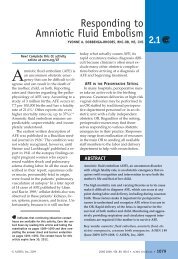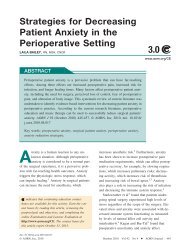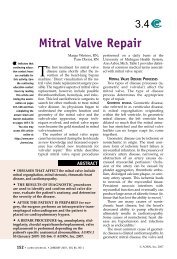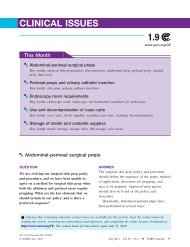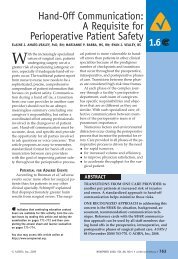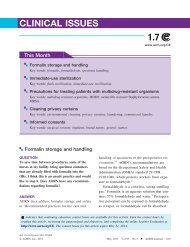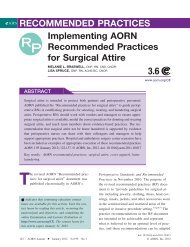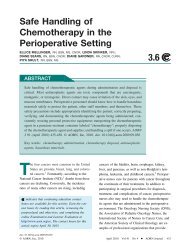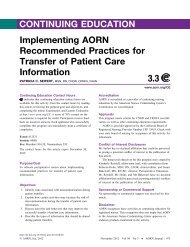September 2010 Vol 92 No 3 BENNICOFFTHE LITHOTOMY POSITIONThe lithotomy position is used to allow maximumsurgical exposure <strong>in</strong> vag<strong>in</strong>al, rectal, and urologicprocedures. There are four levels <strong>of</strong> <strong>the</strong> lithotomyposition rang<strong>in</strong>g from low lithotomy, whichplaces a patient’s legs at approximately a35-degree angle to his or her recumbent torso, to<strong>the</strong> exaggerated lithotomy position with <strong>the</strong> patient’slegs at more than a 90-degree angle. 5<strong>Patient</strong> leg abductionshould be limited to<strong>the</strong> degree neededfor adequate surgicalexposure to avoidstress on <strong>the</strong> patient’ship jo<strong>in</strong>ts andprevent compromise<strong>of</strong> lower extremitycirculation. 6 Physiologicresponses, <strong>in</strong>clud<strong>in</strong>g musculoskeletal, cutaneousand neurologic, and respiratory and hemodynamicresponses occur when <strong>the</strong> patient’s legsare elevated <strong>in</strong>to lithotomy stirrups; perioperativeteam members must take <strong>the</strong>se issues <strong>in</strong>to considerationwhen car<strong>in</strong>g for patients undergo<strong>in</strong>g surgerythat requires <strong>the</strong> lithotomy position. 1,5,7Potential Musculoskeletal ComplicationsInjuries to <strong>the</strong> patient’s hips and knees can resultfrom lithotomy position<strong>in</strong>g. Abductor muscles andhip capsule jo<strong>in</strong>t problems can develop if <strong>the</strong> patient’slegs are stretched or <strong>the</strong> patient rema<strong>in</strong>s <strong>in</strong><strong>the</strong> lithotomy position for an extended period.The patient’s f<strong>in</strong>gers, if tucked at his or her sides,are <strong>in</strong> danger <strong>of</strong> <strong>in</strong>jury when <strong>the</strong> bottom <strong>of</strong> <strong>the</strong>OR bed is raised or lowered. 5Potential Cutaneous andNeurologic ComplicationsS<strong>of</strong>t tissue problems can result from <strong>in</strong>correcthandl<strong>in</strong>g or position<strong>in</strong>g by health care providersand can <strong>in</strong>clude <strong>in</strong>juries to <strong>the</strong> patient’s femoral,cutaneous, sciatic, and obturator nerves. Pressurepo<strong>in</strong>ts from <strong>in</strong>adequate padd<strong>in</strong>g and position<strong>in</strong>gmay cause tissue damage. Shear<strong>in</strong>g force fromchanges <strong>in</strong> position can damage sk<strong>in</strong> tissue, especially<strong>in</strong> patients who are older, debilitated, orobese. Proper patient-mov<strong>in</strong>g techniques shouldbe used to prevent shear<strong>in</strong>g forces.Potential Respiratory andHemodynamic ComplicationsRespiratory complications can occur because <strong>the</strong>patient’s abdom<strong>in</strong>al organs shift when <strong>the</strong> patient’slegs are raised and placed <strong>in</strong> stirrups. This<strong>in</strong>creases pressure on<strong>the</strong> diaphragm andcan result <strong>in</strong> respiratorycompromise. 5Rais<strong>in</strong>g or lower<strong>in</strong>g<strong>the</strong> patient’s legs toorapidly can result <strong>in</strong>fluid volume shiftsthat affect bloodpressure. When teammembers lower <strong>the</strong> patient’s legs after <strong>the</strong> procedure,fluid volume deficits can quickly becomemore obvious, mak<strong>in</strong>g <strong>the</strong> patient’s hemodynamicstatus unstable and complicat<strong>in</strong>g <strong>the</strong> anes<strong>the</strong>siacare provider’s management <strong>of</strong> <strong>the</strong> patient. 5<strong>Patient</strong>s who are morbidly obese can experience<strong>the</strong> common position<strong>in</strong>g problems that placeany patient at risk, and morbid obesity <strong>in</strong>creasesa patient’s risk <strong>of</strong> additional complications that<strong>the</strong> nurse must consider <strong>in</strong> <strong>the</strong> plan <strong>of</strong> care.GENERAL NURSING CARE FOR PATIENTSWHO ARE MORBIDLY OBESE<strong>Patient</strong>s who are morbidly obese present specialchallenges to all members <strong>of</strong> <strong>the</strong> perioperativeteam. These patients can experience any <strong>of</strong> <strong>the</strong>common position<strong>in</strong>g problems that place any patientat risk; however, morbid obesity <strong>in</strong>creases apatient’s risk <strong>of</strong> additional complications thatmust be considered <strong>in</strong> <strong>the</strong> plan <strong>of</strong> care (Table 1). 8Nurs<strong>in</strong>g <strong>in</strong>terventions to prevent problems <strong>in</strong>cludeensur<strong>in</strong>g that sequential compression stock<strong>in</strong>gs fitto prevent constriction and monitor<strong>in</strong>g <strong>the</strong> patient’scloth<strong>in</strong>g and bed l<strong>in</strong>en to prevent constrictionand prevent <strong>the</strong> patient from ly<strong>in</strong>g onbunched or wr<strong>in</strong>kled material that could causetissue damage. Drapes must be large enough tocover <strong>the</strong> patient and provide a sterile field. Instrumentsmust be large enough to provide adequateexposure and allow <strong>the</strong> surgeon to perform298 <strong>AORN</strong> Journal
CARE OF THE OBESE PATIENT IN LITHOTOMYwww.aornjournal.org<strong>the</strong> planned procedure, which may require specialbariatric <strong>in</strong>strument sets.Potential Musculoskeletal ComplicationsAs a result <strong>of</strong> <strong>the</strong> patient’s size and potential mobilitydifficulties, rout<strong>in</strong>e care may be more complicatedand require <strong>the</strong> help <strong>of</strong> additional supportpersonnel to avoid <strong>in</strong>jury to <strong>the</strong> patient or staffmembers. 1,5,7 There is an <strong>in</strong>creased risk <strong>of</strong> <strong>in</strong>jur<strong>in</strong>g<strong>the</strong> patient’s jo<strong>in</strong>ts, muscles, nerves, and s<strong>of</strong>ttissues when lift<strong>in</strong>g and mov<strong>in</strong>g <strong>the</strong> patient because<strong>of</strong> his or her size, and <strong>the</strong> <strong>in</strong>ability <strong>of</strong>health care providers to clearly see <strong>the</strong> patient’sanatomic markers (eg, jo<strong>in</strong>ts) can make safe kneeand hip flexion difficult to determ<strong>in</strong>e. 1,5,7 Overabductioncan occur because <strong>of</strong> <strong>the</strong> size and weight<strong>of</strong> <strong>the</strong> patient’s thighs and <strong>the</strong> need to create adequatespace <strong>in</strong> which <strong>the</strong> surgeon and staffmembers can work. 1,5,7 For example, <strong>the</strong> nurseshould have additional personnel support <strong>the</strong>patient’s legs and prevent overabduction whenplac<strong>in</strong>g <strong>the</strong> patient <strong>in</strong> <strong>the</strong> frog leg position dur<strong>in</strong>g<strong>in</strong>sertion <strong>of</strong> an <strong>in</strong>dwell<strong>in</strong>g ur<strong>in</strong>ary ca<strong>the</strong>ter.Potential Anes<strong>the</strong>tic Complications<strong>Patient</strong>s who are morbidly obese present significantchallenges for <strong>the</strong> anes<strong>the</strong>sia care provider.Often, <strong>the</strong>se patients experience medication problemsas a result <strong>of</strong> altered absorption and <strong>in</strong>creasedstorage <strong>of</strong> medications <strong>in</strong> <strong>the</strong>ir excess fat.Cardiovascular and respiratory concerns may <strong>in</strong>clude<strong>in</strong>creased cardiac afterload, decreased oxygensupply, and a respiratory system taxed by<strong>in</strong>creased fat metabolism. 9 Additional chestweight, abdom<strong>in</strong>al pressure, and <strong>the</strong> presence <strong>of</strong>coexist<strong>in</strong>g conditions unrelated to <strong>the</strong> procedure(eg, hiatal hernia, sleep apnea) <strong>in</strong>crease <strong>the</strong> patient’srespiratory workload. The patient’s chestweight and abdom<strong>in</strong>al pressure also <strong>in</strong>crease <strong>the</strong>patient’s risk <strong>of</strong> aspiration and its serious consequences.9 Intubat<strong>in</strong>g a patient who is morbidlyobese can be difficult because <strong>of</strong> limited cervicalneck movement, reduced oxygen reserves, and<strong>in</strong>creased oxygen consumption. 9 Anes<strong>the</strong>sia careproviders may have difficulty see<strong>in</strong>g <strong>the</strong> vocalcords because <strong>of</strong> limited neck movement and fatdeposits that can obstruct <strong>the</strong> airway. As a result<strong>of</strong> <strong>the</strong>se complications, <strong>in</strong>tubat<strong>in</strong>g <strong>the</strong> patientwhile he or she is awake may be necessary. 9 Theanes<strong>the</strong>sia care provider may require special headposition<strong>in</strong>g and support aids such as an airwaymanagement head cradle and an elevation wedgespecifically designed to assist with <strong>in</strong>duction andhead support dur<strong>in</strong>g procedures on patients whoare obese. Emergency response carts also shouldbe <strong>in</strong> <strong>the</strong> room <strong>in</strong> <strong>the</strong> event <strong>of</strong> a difficult <strong>in</strong>tubationor o<strong>the</strong>r emergency. The patient also mayrequire appropriately sized blood pressure cuffs.Potential Cardiovascular ComplicationsCardiac conditions that <strong>of</strong>ten present <strong>in</strong> patientswho are morbidly obese may <strong>in</strong>clude hypertension,diabetes, bradycardia or tachycardia, andslow cardiac conduction and ischemia. As a complicat<strong>in</strong>gfactor, <strong>the</strong> electrocardiogram conductionsignal may be distorted as a result <strong>of</strong> excess chestfat. Fur<strong>the</strong>rmore, patients who are obese have an<strong>in</strong>creased <strong>in</strong>cidence <strong>of</strong> deep ve<strong>in</strong> thrombosis, andsuperficial ve<strong>in</strong>s may be difficult to access for IVplacement. 9PLACING THE PATIENT WHO ISMORBIDLY OBESE IN THELITHOTOMY POSITION“<strong>Obese</strong> patients are more prone to difficulty withposition<strong>in</strong>g and position<strong>in</strong>g <strong>in</strong>juries dur<strong>in</strong>g surgerybecause <strong>of</strong> <strong>the</strong> stra<strong>in</strong> excessive weight places on<strong>the</strong>ir musculoskeletal and nervous systems.” 9(p45)<strong>Patient</strong>s who are obese also may present with exist<strong>in</strong>gareas <strong>of</strong> sk<strong>in</strong> damage that need to be assessedand taken <strong>in</strong>to consideration dur<strong>in</strong>g position<strong>in</strong>g.It is imperative that <strong>the</strong> perioperative nurse hasa preoperative discussion with <strong>the</strong> surgeon and<strong>the</strong> anes<strong>the</strong>sia care provider about plans andneeds for <strong>the</strong> surgery. The circulat<strong>in</strong>g nurseshould perform a careful preoperative assessment<strong>of</strong> <strong>the</strong> patient to identify cardiac, vascular, or neurologicconditions that could affect <strong>the</strong> patient’ssafety or care dur<strong>in</strong>g surgery. Additionally, <strong>the</strong>nurse should identify any issues that might<strong>AORN</strong> Journal 299



